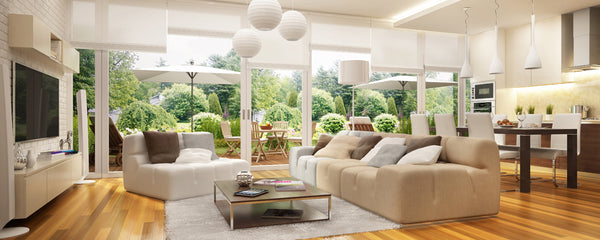On orders $99+
On orders $99+

Welcome to the world of indoor lighting, where the right luminescence can turn a house into a home and a room into a sanctuary. For DIY enthusiasts and budding interior designers, understanding the multifaceted nature of lighting is akin to holding the key to creating spaces that are not only functional but truly magical. Let's embark on a journey through the art and science of indoor lighting.
Lighting a home is much like painting; your light sources are your brushes, and the spectrum of light is your palette. The goal? To create a masterpiece that is as inviting as it is practical. Here are the primary "colors" at your disposal:
Imagine ambient lighting as the base coat of your canvas. It's the soft, overhead light that washes over a room, setting the initial tone and mood. From the gentle glow of a flush mount ceiling fixture to the diffused light of LED recessed lights, ambient lighting is about creating a consistent layer of illumination that acts as a backdrop for your daily life.
Task lighting is your fine brush, designed to illuminate specific activities. Picture a sleek pendant light hanging low over a kitchen island, providing the perfect light for meal prep, or a focused desk lamp casting light on a workspace, banishing shadows to enhance productivity. Task lighting is all about precision, bringing light where it's most needed.
Accent lighting is akin to the final strokes that give a painting depth and dimension. This is the light that highlights your home's architectural features or draws attention to prized possessions. A strategically placed track light can make artwork pop off the walls, while under-cabinet lighting in the kitchen can make a backsplash dazzle. Accent lighting adds layers and interest, turning ordinary spaces into visual experiences.

The color temperature of light, measured in Kelvins (K), dramatically affects the ambiance of a room. Warm lights (2700K - 3000K) emit a cozy, golden glow ideal for living rooms and bedrooms, creating a soothing environment that invites relaxation. Cool white lights (3500K - 4100K), with their crisp, bright ambiance, are excellent for kitchens and bathrooms, promoting alertness and closely mimicking daylight. For areas requiring detailed tasks, a cooler light enhances contrast and clarity.
The challenge lies not just in selecting beautiful home lighting fixtures but in ensuring they serve their intended purpose, enhance the room's aesthetic, and create the desired ambiance. Here, we delve deeper into the art of overcoming common lighting challenges with practical, design-forward solutions.
One of the most nuanced challenges in lighting design is achieving a harmonious balance that respects both the functionality and the aesthetic appeal of a space. Overreliance on a single type of lighting can lead to a room that feels either too clinical or insufficiently lit, disrupting the intended ambiance. The solution lies in the strategic layering of light sources. For instance, in a living room, combine the soft glow of ambient ceiling fixtures with the focused light of floor lamps by reading nooks and accent lights on artwork or architectural details. This approach not only ensures a well-lit space but also adds visual interest and depth, allowing for activities that range from the leisurely to the focused.
Another common puzzle is integrating lighting fixtures that match the room's decor while providing adequate illumination. This balancing act requires a keen eye for design and an understanding of lighting's functional roles. Start by identifying the style and mood you wish to evoke in each room. A sleek, contemporary kitchen, for example, might benefit from under-cabinet LED strips that offer task lighting without detracting from the minimalist aesthetic. In contrast, a vintage-inspired bedroom could be enhanced with an ornate chandelier that provides ambient lighting while serving as a statement piece. By selecting fixtures that reflect the room's style, you create a cohesive look that enhances both the room's beauty and its usability.
Each room in your home serves unique functions, necessitating a customized lighting approach. A common oversight is applying a uniform lighting strategy across different spaces, which can lead to areas that are either under-lit or overly bright. The key is to adapt your lighting choices to the specific needs and activities of each room. In the kitchen, ensure countertops are well-lit with task lighting for safe food preparation, while in the bathroom, install sconces at eye level to eliminate shadows for grooming tasks. Bedrooms, meanwhile, require a softer approach, with ambient lighting for a tranquil atmosphere and task lighting beside the bed for reading.

The journey through the world of indoor lighting reveals that the best home lighting design is one that considers function, style, and comfort. By mastering the balance of ambient, task, and accent lighting, and choosing fixtures that resonate with your home's design, you can create spaces that are not just seen but felt. Remember, lighting is not just about visibility; it's about vision. As you wield the tools of light, color, and shadow, you have the power to transform the mundane into the extraordinary, crafting indoor spaces that inspire, comfort, and delight.
Helpful Links:
What kind of light is best for a dining room?
What is the best type of lighting for a living room?
Leave a comment